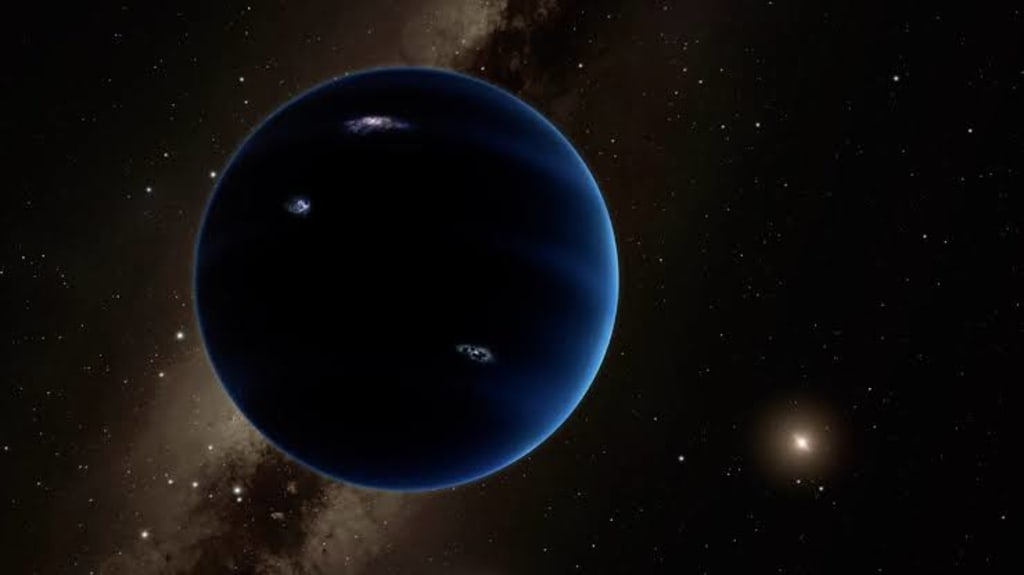Content warning
This story may contain sensitive material or discuss topics that some readers may find distressing. Reader discretion is advised. The views and opinions expressed in this story are those of the author and do not necessarily reflect the official policy or position of Vocal.
Voyage of Wonder: Unraveling the Cosmic Mysteries
Exploring the Celestial Marvels and Our Place in the Vast Cosmos

Imagine embarking on a remarkable journey far from Earth, where your spacecraft gracefully parks near the Moon, taking you almost 240,000 miles away from your home planet. This cosmic distance is equivalent to roughly 100 times the width of the United States. Equipped with a colossal hammer and an enormous chisel, you muster the courage to strike the Earth's north pole, envisioning a sight akin to an eggshell cracking open. To your astonishment, an awe-inspiring revelation awaits you within - another planet named Thea, concealed inside Earth much like a yolk nestling in an egg's core. Unraveling this profound mystery demands a sojourn through time, dating back an astonishing 4.5 billion years, to fathom the profound origins of this celestial spectacle.
The mesmerizing saga begins with a spectacular nebula, a cosmic nursery that would eventually give birth to our awe-inspiring solar system. Within this nebulous haven, vibrant dust particles and assorted space debris converge, forming an intricate cosmic puzzle that will soon unfold into something spectacular. As the cosmic mass thickens and heat intensifies, an extraordinary nuclear chain reaction commences, culminating in a monumental explosion that sends shockwaves cascading through the universe. This awe-inspiring flash is so radiant that it becomes visible from the far reaches of the Milky Way galaxy.
Once the celestial spectacle subsides, a brilliant light emerges at the epicenter - our newborn star, the Sun, a cosmic behemoth weighing as much as an astounding 333,000 Earths. Simultaneously, 93 million miles away from this scintillating star, Earth embarks on its evolution, characterized by oceans of flowing lava gradually cooling and shaping the very fabric of this nascent world. Over the course of several tens of millions of years, Earth's neighbor, Thea, journeys toward it. Guided by the gravitational pulls of Venus and Jupiter, Thea embarks on a tumultuous trajectory, eventually gravitating towards an unavoidable cosmic collision course with Earth.
With Thea hurtling at nearly 9,000 miles per hour, the momentous impact materializes at an immaculate 45-degree angle. This titanic collision results in a cataclysmic explosion, vaporizing rocks and projecting debris into Earth's orbit. This momentous event culminates in the creation of a colossal crater and the birth of a newly formed moon. As the eons pass, the moon's existence profoundly impacts Earth's geographical features, climate patterns, and the very essence of its lithospheric plates that compose the crust.
The collision with Thea stands as a cosmic rarity, with the likelihood of encountering a surviving civilization amidst such an event in the vast universe being astonishingly minuscule. Even to this day, remnants of Thea linger on Earth, with certain fragments seamlessly blending into the Earth's crust, and perhaps others finding their resting place on the enigmatic moon.
Amidst the cosmic dance, Earth continues to gracefully orbit the Sun, becoming a celestial beacon enveloped by a delicate balance of life-sustaining gases within its atmosphere. Yet, if the celestial siblings of Venus and Mars dared to intrude upon Earth's orbit, the ramifications would be dire. Earth's delicate balance would be perturbed, ushering in extreme climate shifts, surging sea levels, and heightened seismic activity.
Despite the formidable challenges, Earth stands as a celestial marvel, brimming with diverse landscapes and intricate workings that never fail to captivate humanity. Its beauty and complexity continue to inspire exploration, evoking wonder in the vastness of the cosmos.
As the cosmic saga unfolds, the celestial spotlight shifts to Pluto, a celestial enigma once regarded as the ninth planet, but now a prominent figure in the Kuiper Belt, classified as the largest dwarf planet. This distant and frigid world boasts an otherworldly landscape adorned with icy surfaces and frozen methane. A mysterious red stain resembling a majestic whale graces its equator, evoking curiosity about Pluto's peculiar orbit and intriguing tectonic activities.
Amidst the cosmic wonders, a peculiar phenomenon emerges - Moon dust, the fine powder blanketing the lunar surface. Astronauts returning from lunar expeditions were taken aback, reporting a curious scent akin to gunpowder when encountering the lunar dust. Surprisingly, Moon dust bears little resemblance to actual gunpowder. It primarily comprises silicon dioxide glass, forged by meteorite impacts on the lunar terrain. The intriguing olfactory experience encountered by astronauts upon returning to Earth might be attributed to a chemical reaction between Moon dust, solar wind, and atmospheric moisture.
Venturing into the lunar depths, hidden secrets emerge in the form of lunar tubes, vast subterranean caverns crafted through ancient lava flows. These natural wonders hold the potential to provide a haven for astronauts or even offer an ideal setting for a thriving lunar colony.
In conclusion, our solar system emerges as a celestial canvas, adorned with captivating celestial bodies, each boasting its own unique features and concealed mysteries, eagerly awaiting the intrepid explorations of future generations. As humanity's quest for knowledge propels us through the cosmos, the universe graciously reveals its secrets, beckoning us to witness the magnificent marvels enshrined within its cosmic embrace.
About the Creator
Enjoyed the story? Support the Creator.
Subscribe for free to receive all their stories in your feed. You could also pledge your support or give them a one-off tip, letting them know you appreciate their work.






Comments
There are no comments for this story
Be the first to respond and start the conversation.